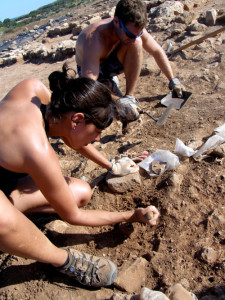5 August 2016 – Every summer my wife and I take a 4-week holiday, usually in Greece but not always. It’s usually a summer of sun-sand-sea but we always mix in a little “brain stuff” like joining an archaeological dig (one of my wife’s passions since university days), or one of the ARCHELON projects to save sea turtles or protecting other marine wildlife (my thing).
This year is a bit different in that we’ll be taking a course in ancient DNA, a collateral program run by the specialized Ancient DNA Lab at the Natural History Museum in London. We’ve been long-time members of the Museum and we’ve already been through the molecular archaeology and bio-archaeology palaeobiology evolutionary genetics program so this will be great fun.
Fossils of archaic hominins hold more secrets to the history of human evolution than we could possibly have imagined. The finding that DNA can still persist in some fossil records, and, more importantly, be successfully extracted, amplified, and sequenced, came with a big promise: to help answer long-standing questions about the evolutionary origins of modern humans, their patterns of migration and interactions with their closest relatives — the Neanderthals — with whom we now know they coexisted in Europe over thousands of years. Thanks to many years of research into ancient DNA and important technical advances in high-throughput sequencing that allowed the sequencing of the complete genome of a Neanderthal woman from the Altai Mountains in Siberia, we know now that there’s a little bit of Neanderthal in everyone whose roots are outside Africa.
But how do these small portions of archaic DNA affect people today? Further insights into Neanderthal genetic contributions and their relevance were offered by subsequent studies. For instance, some Neanderthal-derived alleles may have conferred an evolutionary advantage to modern humans, by helping them cope with environments outside Africa. However, there were also fitness costs to interbreeding, as other variants appear to confer risk for disease. On the flip side, these studies also reported regions in our genomes that were depleted of Neanderthal lineages.
Very little is known about the genetic composition of the early modern humans who arrived in Europe approximately 45,000 years ago and lived there even when Europe was covered in ice during the last glacial period. But a British team is assembling and analyzing genome-wide data from 51 modern humans who lived in Eurasia 45,000–7,000 years ago which will — hopefully — offer important insights into the complex population history of pre-Neolithic Europe. While there is no evidence that the earliest modern humans significantly contributed to the present-day European gene pool, it appears that European populations from around 37,000 years ago onward share some ancestry with current Europeans.
Collectively, these studies provide a glimpse into the incredibly fast-paced field of paleogenomics, or the study of ancient DNA. And none of this would have been possible without the advanced digital analytics we have today.
NOTE: there are some fascinating computational challenges in the digital analysis of ancient DNA. For example, results of high-throughout analyses of DNA libraries may include chimeric sequences, sequencing error and artifacts, damage, and alignment ambiguities due to the short read lengths. It is (somewhat) of an off-shoot of the scientific discussions about DNA as a player in digital informatics, the whole idea of DNA as a reliable catalogue of an organism’s genetic information which makes it well-suited … its proponents claim … for the long-term storage of large volumes of digital information. Fodder for a future post.
But working with ancient DNA is not without challenges, and for a long time the field had endured more failures than successes. Not only do DNA sequences from ancient sources show base damage and fragmentation into short pieces, but the majority of DNA recovered from many specimens is actually of microbial origin. Furthermore, contamination with modern human DNA (derived from human handling during excavations or in museums) is also very common. In addition to working under strict clean laboratory conditions, appropriate sequencing and computational methods are also required to correct and mitigate biases and ensure that the identification of bona fide archaic sequences is accurate.
How contemporary humans originated is a fascinating question that embraces all of us, regardless of ethnicity or culture. Ancient genomes have provided priceless snapshots into our history, and, like all exciting research subjects, answering one question generates many more interesting avenues for investigations. One obvious open question is what exactly sets us apart from earlier and archaic hominins. How did they live, behave, and communicate? Did they have the ability for critical thinking? Maybe the immense curiosity about our ancestry is one of the many things that makes us humans.
